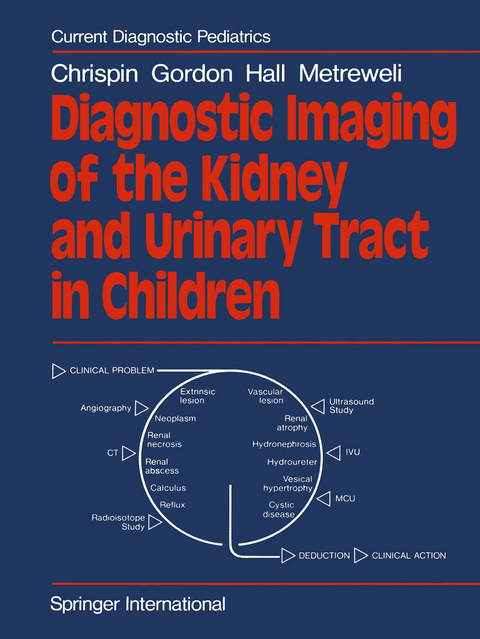
Diagnostic Imaging of the Kidney and Urinary Tract in Children
Springer London Ltd (Verlag)
978-1-4471-3099-4 (ISBN)
All unsuccessful revolutions are the same, but each successful one is different in its own distinctive way. The reason why revolutions occur is that new forces attain increasing significance and classic institutions are incapable of accomodating these forces. Such has been the pattern of events in the English, American and French revolutions. These successful revolutions produced a new dynamic and new perspectives. One English revolutionary put this succinctly: "Let us be doing, but let us be united in doing". This book sets out what is a revolution in. the perspectives of diagnostic imaging of the kidney and urinary tract. Forces which have brought about this revolution are the advent of reliable techniques in radioisotope studies, ultrasonics and computerized tomographic (CT) scanning. This last modality carries with it specific problems for routine paediatric work and its role in the study of kidney and urinary tract problems is discrete and circumscribed. However, in conjunction with classic radiology, each of these techniques yields information of a different type and so a synthesis of data accrues.
1 The Clinical Context.- 1.1 Introduction.- 1.2 Renal Failure.- 1.3 Enuresis — Retention — Incontinence.- 1.4 Oliguria.- 1.5 Polyuria.- 1.6 Haematuria.- 1.7 Urinary Infection.- 1.8 Pain.- 1.9 Complexes, Syndromes and Conditions of a Generalised Nature.- 1.10 Conclusion.- 2 Investigatory Techniques.- 2.1 Introduction.- 2.2 Intravenous Urography (IVU).- 2.3 Micturition Cystourethrography (MCU).- 2.4 Injection Urethrography.- 2.5 Retrograde and Descending Contrast Medium Studies by Injection.- 2.6 Ultrasonography.- 2.7 Radioisotope Studies.- 2.8 Angiography.- 2.9 Urodynamics.- 2.10 Computed Tomography.- 2.11 Strategy and Tactics in Investigation.- 3 Obstruction in the Urinary Tract.- 3.1 Introduction.- 3.2 Acute Obstruction of the Kidney.- 3.3 Protracted Obstruction.- 3.4 Tactics in Investigation of Patients with Suspected Obstruction.- 3.5 Monitoring Progress.- 4 Urinary Infection and Vesico-ureteral Reflux.- 4.1 Introduction.- 4.2 Infection and the Bladder.- 4.3 Ureterovesical Junction: Functional Characteristics.- 4.4 Significant Factors in Vesico-Ureteral Reflux.- 4.5 Acute Kidney Infection and the Advent of the Pyelonephritic Scar.- 4.6 Sequels to Renal Scarring and Reflux.- 4.7 Investigations and Implications for Management in Urinary Infection.- 4.8 Collateral Considerations.- 4.9 Miscellaneous Urinary Infections.- 5 Nephrocalcinosis—Nephrolithiasis—Urolithiasis.- 5.1 Introduction.- 5.2 Causes of Nephrocalcinosis, Nephrolithiasis, and Urolithiasis.- 5.3 Investigation.- 5.4 Consequences of Calculi in the Urinary Tract.- 5.5 Miscellaneous Considerations Concerning the Lower Urinary Tract.- 5.6 Conclusion.- 6 Innate Abnormalities of Renal Development.- 6.1 Introduction.- 6.2 Abnormalities of Renal Parenchymal Development.- 6.3 Absent Abdominal Muscles (PruneBelly) Syndrome and Variants.- 6.4 Duplication in the Kidney and Ureters.- 7 Vesical and Urethral Problems.- 7.1 Introduction.- 7.2 Developmental Variants.- 7.3 Neoplastic Disease.- 7.4 Cystitis.- 7.5 Neuropathic Bladder.- 8 Acute Kidney Lesions.- 8.1 Introduction.- 8.2 Shock States and Kidney Damage.- 8.3 Nephritis.- 8.4 Miscellaneous Types of Kidney Damage.- 9 Renal Abdominal and Pelvic Masses.- 9.1 Introduction.- 9.2 Renal Neoplasms.- 9.3 Non-Neoplastic Renal Masses and Lesions Simulating Masses.- 9.4 Extrinsic Malignant Masses Affecting the Kidney and Urinary Tract.- 9.5 Extrinsic Benign Masses Affecting the Kidney and Urinary Tract.- 9.6 Strategy in Investigation.- 10 Adrenal and Gonadal Lesions.- 10.1 Introduction.- 10.2 Tactics in Investigation of the Adrenal.- 10.3 Adrenal Haemorrhage and Abscess.- 10.4 Congenital Adrenal Hyperplasia (Adrenogenital Syndrome).- 10.5 Cushing’s Syndrome.- 10.6 Virilizing and Feminizing Tumours of the Adrenal Gland or Gonad.- 10.7 Other Gonadal Lesions.- 10.8 Conclusion.- 11 Systemic Hypertension.- 11.1 Introduction.- 11.2 Clinical Presentation.- 11.3 Causes of Hypertension.- 11.4 Conclusion: Tactics in Investigation.- 12 Bone Changes in Chronic Renal Failure.- 12.1 Introduction.- 12.2 Cortical Bone.- 12.3 Cancellous Bone.- 12.4 Diaphyseal Lesion.- 12.5 Epiphyseal Lesion.- 12.6 General Considerations.- 12.7 Clinical Presentation.- 12.8 Conclusion.- 13 Full Circle: An Epilogue.- 13.1 Large Kidneys.- 13.2 Englargement of one Kidney.- 13.3 Small Kidneys.- 13.4 Renal Malposition.- 13.5 Renal Calcification.- 13.6 Dilated Ureters.- 13.7 Ureteric Displacement.- 13.8 Large Bladder.- 13.9 Small Bladder.- 13.10 Bladder Displacement.- 13.11 Space-occupying Lesions in Bladder.- 13.12 Syndromes with Associated Renal Malformations.- 13.13Syndromes Associated with Renal Cysts.- 13.14 Syndromes Associated with Nephropathy.- 13.15 Congenital Renal Anomalies Associated with Other System Involvement.- 13.16 Hemihypertrophy.- 13.17 Conclusion.- 14 Subject Index.
| Reihe/Serie | Current Diagnostic Pediatrics |
|---|---|
| Zusatzinfo | XIX, 208 p. |
| Verlagsort | England |
| Sprache | englisch |
| Maße | 210 x 280 mm |
| Themenwelt | Medizinische Fachgebiete ► Innere Medizin ► Nephrologie |
| Medizin / Pharmazie ► Medizinische Fachgebiete ► Pädiatrie | |
| Medizinische Fachgebiete ► Radiologie / Bildgebende Verfahren ► Radiologie | |
| Medizin / Pharmazie ► Medizinische Fachgebiete ► Urologie | |
| Medizin / Pharmazie ► Studium ► 1. Studienabschnitt (Vorklinik) | |
| Naturwissenschaften ► Biologie ► Biochemie | |
| Schlagworte | kidney • Medizinische Radiologie • Ultraschalldiagnostik • Urologie |
| ISBN-10 | 1-4471-3099-5 / 1447130995 |
| ISBN-13 | 978-1-4471-3099-4 / 9781447130994 |
| Zustand | Neuware |
| Informationen gemäß Produktsicherheitsverordnung (GPSR) | |
| Haben Sie eine Frage zum Produkt? |
aus dem Bereich


